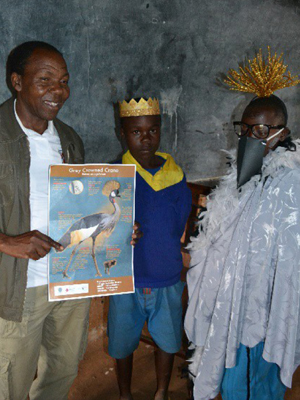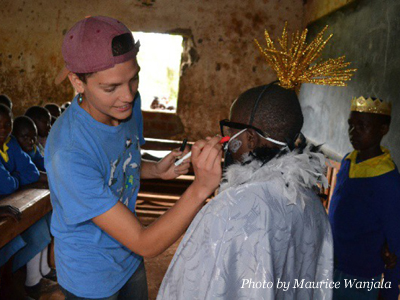 A story passed down to Maurice Wanjala, Kenya Crane and Wetland Conservation Program Manager, from his maternal grandmom and grandad.
A story passed down to Maurice Wanjala, Kenya Crane and Wetland Conservation Program Manager, from his maternal grandmom and grandad.
“Once upon a time all the animals lived in a community, and the lion was their king. One day, the lioness convinced the lion to test the loyalty of his subjects by pretending he was dead. So the lion lay “dead” and waited to see what the animals would do. First the zebras came close, and they were happy upon discovering their ruler had died. They ran away as a group, celebrating. The hyenas passed by next, and upon seeing the dead lion began laughing and mocking him “Heh-hey!” “Oohwee!” When Hadada Ibis (Ng’ang’a in the local language) saw the lion, she was upset and flew off crying loudly “Ng’a- ng’a- ng’a!” “Ng’a- ng’a- ng’a!” The Grey Crowned Crane heard these cries and came to confirm. When he saw his beloved king was no longer, he mourned “Oh why? Oh why? Oh why? Did you die? Oh why did you die? What gonna we do without you?”
After all this the lion arose and convened a meeting of the entire animal community. To the zebra he said, “From now on you are no longer my friend. I will chase you and tear you into pieces.” Next he declared the hyena a permanent enemy. The hyena responded “When you are really dead, I will chew even your bones.” Then he called upon Hadada Ibis, thanked her for alerting the community of his death, and said, “I will grant you a long beak and loud voice, to be an alarmist when there is danger.” Finally, to the Grey Crowned Crane he said “You were the only one to truly mourn my death. I will make you my right hand in the animal community, and you will inform me of all happenings, including deaths. To reward you for your loyalty, I grant you this crown, so you can fly and walk beside me as the queen of our kingdom.”
![]() During recent visits to local schools in Kipsaina in western Kenya, Maurice shared the story of How the Crane Got Its Crown with School Conservation Club students, using gold crown props and having students act as the different animals. The club leaders had each attended a teacher training workshop in October 2015 to learn new approaches to environmental education and discuss how to revive or strengthen their school clubs. Many cultural stories about cranes were exchanged during the workshop, and the teachers lamented that the younger generation has not inherited such traditions.
During recent visits to local schools in Kipsaina in western Kenya, Maurice shared the story of How the Crane Got Its Crown with School Conservation Club students, using gold crown props and having students act as the different animals. The club leaders had each attended a teacher training workshop in October 2015 to learn new approaches to environmental education and discuss how to revive or strengthen their school clubs. Many cultural stories about cranes were exchanged during the workshop, and the teachers lamented that the younger generation has not inherited such traditions.
After Maurice shared the cultural reasons for the crane’s beautiful crown, visiting teacher, Monique Picon, explained that the crown helps cranes hide in tall reeds. She then dressed a student with feathers, a bill and gular sac, and other crane adaptations, while explaining the biology behind each one.
 The students also learned that Grey Crowned Cranes are endangered and are rapidly declining in East Africa due to habitat loss, poisoning, and illegal trade. As a result, in addition to exciting students about cranes, school visits ensure that club leaders and school principals are taking steps to strengthen environmental education programs. Each school will be “adopting” a nearby stretch of wetlands, where they will monitor cranes and threats to the wetland regularly. Several schools informed us that they’ll be reviving tree nurseries or fish ponds that Maurice initiated in the past. One principal announced plans to fence off the wetlands behind his school to keep the community from grazing livestock on wetland vegetation.
The students also learned that Grey Crowned Cranes are endangered and are rapidly declining in East Africa due to habitat loss, poisoning, and illegal trade. As a result, in addition to exciting students about cranes, school visits ensure that club leaders and school principals are taking steps to strengthen environmental education programs. Each school will be “adopting” a nearby stretch of wetlands, where they will monitor cranes and threats to the wetland regularly. Several schools informed us that they’ll be reviving tree nurseries or fish ponds that Maurice initiated in the past. One principal announced plans to fence off the wetlands behind his school to keep the community from grazing livestock on wetland vegetation.
A second teacher training will be held to learn how well these new approaches are working and introduce a few more education and monitoring tools. Over the course of the next year, Maurice will be visiting these schools each month to monitor school progress and collect information about the adopted wetlands and their cranes. We hope that you agree that the future is looking bright for both cranes and people in Kipsaina!
